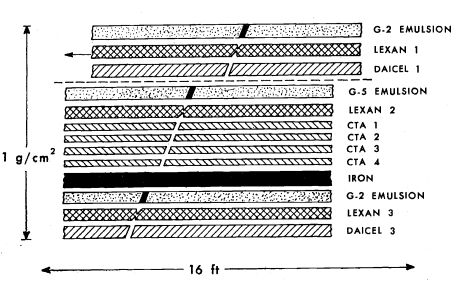Purpose of the flight and payload description
The payload was composed by an stack of plastics, emulsions, and iron absorbers. The figure at left show the composition of the stack. The upper portion of it contained a motor-driven, shiftable layer of G-2 emulsion + Lexan polycarbonate + Daicell cellulose nitrate so that events occurring at ceiling altitude could be singled out. The iron slab was inserted to bring the total thickness to 1 g/cm2 so that tracks of nuclei with velocity much less than that for the geomagnetic cutoff on which the balloon flew, could be easily recognized and discarded.
The upper and lower emulsion layers were of type G-2 and were used mainly for following tracks through the stack. The most sensitive plastic, Daicell, recorded relativistic nuclei with Z>30, but because of its non-uniform composition and response, it was only used for location of tracks of heavy nuclei in the stack. In the other hand, the Eastman cellulose triacetate without plasticizer (CTA) was quite uniform in composition and reliable in response, so it was used to identify nuclei with Z>40.
Details of the balloon flight
Balloon launched on: 9/25/1968 at 19:33 cdt
Launch site: Columbia Scientific Balloon Facility, Palestine, Texas, US
Balloon launched by: National Center for Atmospheric Research (NCAR)
Balloon manufacturer/size/composition: Zero Pressure Balloon Winzen 15.400.000 cuft (Vista Dome 0.75 mil. Stratofilm)
Balloon serial number: 2363-S-545-8342 Serial Nº 101
Flight identification number: 433P
End of flight (L for landing time, W for last contact, otherwise termination time): 9/25/1968
Balloon flight duration (F: time at float only, otherwise total flight time in d:days / h:hours or m:minutes - ): ~ 30 m
Landing site: In Oakwood, Texas, US
Payload weight: 1496 lbs.
The balloon used in this flight was of a new design called "Vista-Cone" manufactured by Raven Industries and had a volume of 15.4 million cubic feet. It was succesfuly launched on 25 September 1968, but during the initial portion of the flight it rose very slowly. 280 lbs. of ballast was expended driving the balloon to 10,000 feet. However, after spending 12 minutes at that altitude, was evident that the balloon was leaking and the flight was terminated.
External references
- Identification of tracks of super heavy cosmic rays in plastics 11th International Conference on Cosmic Rays, held in Budapest, 25 August - 4 September, 1969
- NCAR Scientific Balloon Facility Annual Report, 1968 p. A-35 National Center for Atmospheric Research, January 1969
4077If you consider this website interesting or useful, you can help me to keep it up and running with a small donation to cover the operational costs. Just the equivalent of the price of a cup of coffee helps a lot.


